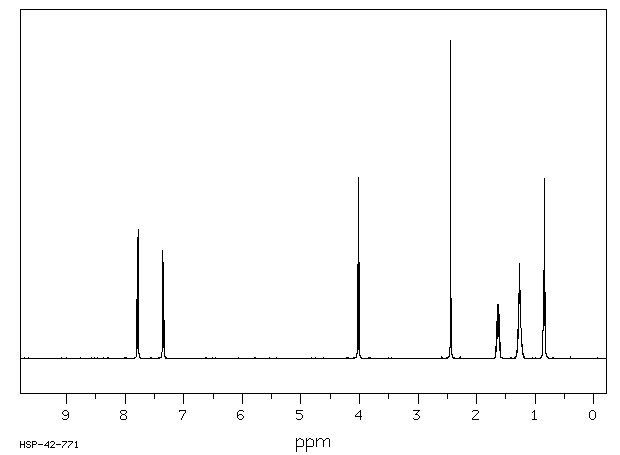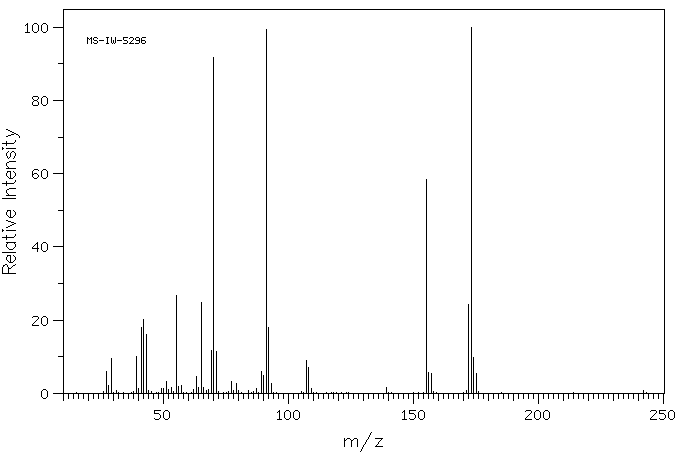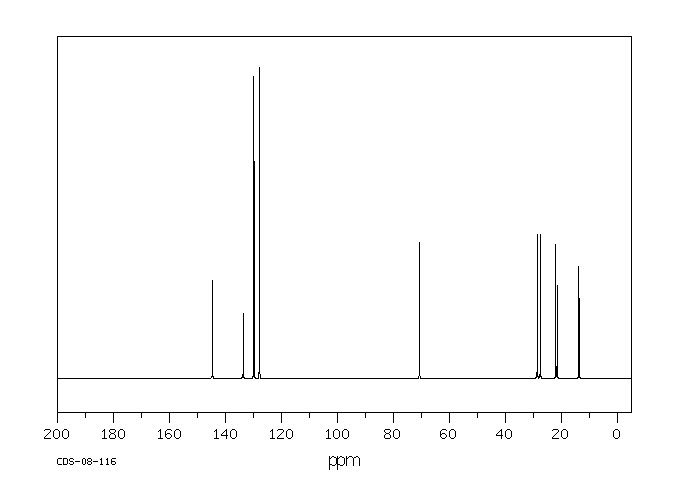甲苯-4-磺酸戊酯 | 4450-76-4
中文名称
甲苯-4-磺酸戊酯
中文别名
(2R,3R)-2-(4-羟基苯基)-3,4-二氢-2H-色烯-3,5,7-三醇
英文名称
1-pentyl tosylate
英文别名
n-pentyl tosylate;n-pentyl p-toluenesulfonate;pentyl p-toluenesulfonate;pentyl 4-methylbenzenesulfonate;p-toluenesulfonic-acid-2-propylethylester;Pentyl toluene-4-sulphonate
CAS
4450-76-4
化学式
C12H18O3S
mdl
——
分子量
242.339
InChiKey
KOUCTZDKTJGHSS-UHFFFAOYSA-N
BEILSTEIN
——
EINECS
——
-
物化性质
-
计算性质
-
ADMET
-
安全信息
-
SDS
-
制备方法与用途
-
上下游信息
-
文献信息
-
表征谱图
-
同类化合物
-
相关功能分类
-
相关结构分类
物化性质
-
沸点:349.9±11.0 °C(Predicted)
-
密度:1.102±0.06 g/cm3(Predicted)
计算性质
-
辛醇/水分配系数(LogP):3.2
-
重原子数:16
-
可旋转键数:6
-
环数:1.0
-
sp3杂化的碳原子比例:0.5
-
拓扑面积:51.8
-
氢给体数:0
-
氢受体数:3
安全信息
-
海关编码:2905199090
-
危险性防范说明:P501,P270,P264,P280,P302+P352,P337+P313,P305+P351+P338,P362+P364,P332+P313,P301+P312+P330
-
危险性描述:H302,H315,H319
-
储存条件:室温和惰性气体环境下
SDS
Section 1. IDENTIFICATION OF THE SUBSTANCE/MIXTURE
Product identifiers
Product name : Pentyl toluene-4-sulphonate
CAS-No. : 4450-76-4
Relevant identified uses of the substance or mixture and uses advised against
Identified uses : Laboratory chemicals, Manufacture of substances
Section 2. HAZARDS IDENTIFICATION
Classification of the substance or mixture
Classification according to Regulation (EC) No 1272/2008 [EU-GHS/CLP]
Acute toxicity, Oral (Category 4)
Skin irritation (Category 2)
Specific target organ toxicity - single exposure (Category 3)
Chronic aquatic toxicity (Category 4)
Classification according to EU Directives 67/548/EEC or 1999/45/EC
Harmful if swallowed. Irritating to eyes, respiratory system and skin.
Label elements
Labelling according Regulation (EC) No 1272/2008 [CLP]
Pictogram
Signal word Warning
Hazard statement(s)
H302 Harmful if swallowed.
H315 Causes skin irritation.
H335 May cause respiratory irritation.
H413 May cause long lasting harmful effects to aquatic life.
Precautionary statement(s)
P261 Avoid breathing dust/ fume/ gas/ mist/ vapours/ spray.
Supplemental Hazard none
Statements
According to European Directive 67/548/EEC as amended.
Hazard symbol(s)
R-phrase(s)
R22 Harmful if swallowed.
R36/37/38 Irritating to eyes, respiratory system and skin.
S-phrase(s)
S26 In case of contact with eyes, rinse immediately with plenty of water and
seek medical advice.
S36/37 Wear suitable protective clothing and gloves.
Other hazards - none
Section 3. COMPOSITION/INFORMATION ON INGREDIENTS
Substances
Formula : C12H18O3S
Molecular Weight : 242,33 g/mol
Component Concentration
Pentyl toluene-4-sulphonate
CAS-No. 4450-76-4 -
EC-No. 224-693-6
Section 4. FIRST AID MEASURES
Description of first aid measures
General advice
Consult a physician. Show this safety data sheet to the doctor in attendance.
If inhaled
If breathed in, move person into fresh air. If not breathing, give artificial respiration. Consult a physician.
In case of skin contact
Wash off with soap and plenty of water. Consult a physician.
In case of eye contact
Flush eyes with water as a precaution.
If swallowed
Never give anything by mouth to an unconscious person. Rinse mouth with water. Consult a physician.
Most important symptoms and effects, both acute and delayed
To the best of our knowledge, the chemical, physical, and toxicological properties have not been
thoroughly investigated.
Indication of any immediate medical attention and special treatment needed
no data available
Section 5. FIREFIGHTING MEASURES
Extinguishing media
Suitable extinguishing media
Use water spray, alcohol-resistant foam, dry chemical or carbon dioxide.
Special hazards arising from the substance or mixture
Carbon oxides, Sulphur oxides
Advice for firefighters
Wear self contained breathing apparatus for fire fighting if necessary.
Further information
no data available
Section 6. ACCIDENTAL RELEASE MEASURES
Personal precautions, protective equipment and emergency procedures
Use personal protective equipment. Avoid dust formation. Avoid breathing vapors, mist or gas. Ensure
adequate ventilation. Evacuate personnel to safe areas. Avoid breathing dust.
Environmental precautions
Prevent further leakage or spillage if safe to do so. Do not let product enter drains. Discharge into the
environment must be avoided.
Methods and materials for containment and cleaning up
Pick up and arrange disposal without creating dust. Sweep up and shovel. Keep in suitable, closed
containers for disposal.
Reference to other sections
For disposal see section 13.
Section 7. HANDLING AND STORAGE
Precautions for safe handling
Avoid contact with skin and eyes. Avoid formation of dust and aerosols.
Provide appropriate exhaust ventilation at places where dust is formed.Normal measures for preventive fire
protection.
Conditions for safe storage, including any incompatibilities
Store in cool place. Keep container tightly closed in a dry and well-ventilated place.
Specific end uses
no data available
Section 8. EXPOSURE CONTROLS/PERSONAL PROTECTION
Control parameters
Components with workplace control parameters
Exposure controls
Appropriate engineering controls
Handle in accordance with good industrial hygiene and safety practice. Wash hands before breaks and
at the end of workday.
Personal protective equipment
Eye/face protection
Safety glasses with side-shields conforming to EN166 Use equipment for eye protection tested
and approved under appropriate government standards such as NIOSH (US) or EN 166(EU).
Skin protection
Handle with gloves. Gloves must be inspected prior to use. Use proper glove removal technique
(without touching glove's outer surface) to avoid skin contact with this product. Dispose of
contaminated gloves after use in accordance with applicable laws and good laboratory practices.
Wash and dry hands.
The selected protective gloves have to satisfy the specifications of EU Directive 89/686/EEC and
the standard EN 374 derived from it.
Body Protection
Complete suit protecting against chemicals, The type of protective equipment must be selected
according to the concentration and amount of the dangerous substance at the specific workplace.
Respiratory protection
For nuisance exposures use type P95 (US) or type P1 (EU EN 143) particle respirator.For higher
level protection use type OV/AG/P99 (US) or type ABEK-P2 (EU EN 143) respirator cartridges.
Use respirators and components tested and approved under appropriate government standards
such as NIOSH (US) or CEN (EU).
Section 9. PHYSICAL AND CHEMICAL PROPERTIES
Information on basic physical and chemical properties
a) Appearance Form: solid
b) Odour no data available
c) Odour Threshold no data available
d) pH no data available
e) Melting point/freezing no data available
point
f) Initial boiling point and no data available
boiling range
g) Flash point no data available
h) Evaporation rate no data available
i) Flammability (solid, gas) no data available
j) Upper/lower no data available
flammability or
explosive limits
k) Vapour pressure no data available
l) Vapour density no data available
m) Relative density no data available
n) Water solubility no data available
o) Partition coefficient: n- log Pow: 4,116
octanol/water
p) Autoignition no data available
temperature
q) Decomposition no data available
temperature
r) Viscosity no data available
s) Explosive properties no data available
t) Oxidizing properties no data available
Other safety information
no data available
Section 10. STABILITY AND REACTIVITY
Reactivity
no data available
Chemical stability
no data available
Possibility of hazardous reactions
no data available
Conditions to avoid
no data available
Incompatible materials
Oxidizing agents
Hazardous decomposition products
Other decomposition products - no data available
Section 11. TOXICOLOGICAL INFORMATION
Information on toxicological effects
Acute toxicity
no data available
Skin corrosion/irritation
no data available
Serious eye damage/eye irritation
no data available
Respiratory or skin sensitization
no data available
Germ cell mutagenicity
no data available
Carcinogenicity
IARC: No component of this product present at levels greater than or equal to 0.1% is identified as
probable, possible or confirmed human carcinogen by IARC.
Reproductive toxicity
no data available
Specific target organ toxicity - single exposure
Inhalation - May cause respiratory irritation.
Specific target organ toxicity - repeated exposure
no data available
Aspiration hazard
no data available
Potential health effects
Inhalation May be harmful if inhaled. Causes respiratory tract irritation.
Ingestion Harmful if swallowed.
Skin May be harmful if absorbed through skin. Causes skin irritation.
Signs and Symptoms of Exposure
To the best of our knowledge, the chemical, physical, and toxicological properties have not been
thoroughly investigated.
Additional Information
RTECS: Not available
Section 12. ECOLOGICAL INFORMATION
Toxicity
no data available
Persistence and degradability
no data available
Bioaccumulative potential
no data available
Mobility in soil
no data available
Results of PBT and vPvB assessment
no data available
Other adverse effects
no data available
Section 13. DISPOSAL CONSIDERATIONS
Waste treatment methods
Product
Offer surplus and non-recyclable solutions to a licensed disposal company. Contact a licensed
professional waste disposal service to dispose of this material. Dissolve or mix the material with a
combustible solvent and burn in a chemical incinerator equipped with an afterburner and scrubber.
Contaminated packaging
Dispose of as unused product.
Section 14. TRANSPORT INFORMATION
UN number
ADR/RID: - IMDG: - IATA: -
UN proper shipping name
ADR/RID: Not dangerous goods
IMDG: Not dangerous goods
IATA: Not dangerous goods
Transport hazard class(es)
ADR/RID: - IMDG: - IATA: -
Packaging group
ADR/RID: - IMDG: - IATA: -
Environmental hazards
ADR/RID: no IMDG Marine pollutant: no IATA: no
Special precautions for user
no data available
SECTION 15 - REGULATORY INFORMATION
N/A
SECTION 16 - ADDITIONAL INFORMATION
N/A
上下游信息
-
上游原料
中文名称 英文名称 CAS号 化学式 分子量 对甲苯磺酸 toluene-4-sulfonic acid 104-15-4 C7H8O3S 172.205
反应信息
-
作为反应物:描述:参考文献:名称:五硫化二磷还原磺酸摘要:通过用五硫化二磷处理,容易将芳烃和链烷磺酸还原为相应的多硫化物R-(S)n -R(n =2.9≈3.3)。在该反应中,POS和PSH键的形成均被认为是还原的关键步骤。DOI:10.1016/s0040-4039(00)85691-9
-
作为产物:参考文献:名称:蒙脱土粘土催化的乙醇甲苯磺酸化和对甲苯磺酸对二醇的选择性单甲苯磺酸化:一种环境经济途径摘要:描述了直接使用对甲苯磺酸与金属交换的蒙脱石代替对甲苯磺酰氯或对甲苯磺酸酐以高产率直接进行醇的甲苯磺酸化和二醇的选择性单甲苯磺酸酯化的经济经济路线。Fe 3+-蒙脱石粘土是金属交换蒙脱石中对于这种甲苯磺酸化反应最有效的催化剂。活性遵循以下顺序:Fe 3+ > Zn 2+ > Cu 2+ > Al 3+-蒙脱石> K10蒙脱石。可以高纯度实现二醇的区域选择性甲苯磺酸化成单甲苯基化的衍生物。在同时具有伯羟基和仲羟基的二醇中,甲苯磺酰化仅在伯羟基上发生。固体催化剂在环己醇甲苯磺酸化中举例说明的几个循环中显示出一致的活性。DOI:10.1016/s0040-4020(00)00626-8
文献信息
-
TAU-PROTEIN TARGETING PROTACS AND ASSOCIATED METHODS OF USE申请人:Arvinas, Inc.公开号:US20180125821A1公开(公告)日:2018-05-10The present disclosure relates to bifunctional compounds, which find utility as modulators of tau protein. In particular, the present disclosure is directed to bifunctional compounds, which contain on one end a VHL or cereblon ligand which binds to the E3 ubiquitin ligase and on the other end a moiety which binds tau protein, such that tau protein is placed in proximity to the ubiquitin ligase to effect degradation (and inhibition) of tau. The present disclosure exhibits a broad range of pharmacological activities associated with degradation/inhibition of tau protein. Diseases or disorders that result from aggregation or accumulation of tau protein are treated or prevented with compounds and compositions of the present disclosure.本公开涉及双功能化合物,其作为tau蛋白的调节剂具有实用性。具体而言,本公开涉及含有一端结合到E3泛素连接酶的VHL或cereblon配体,另一端结合到tau蛋白的双功能化合物,使得tau蛋白与泛素连接酶靠近,以实现tau蛋白的降解(和抑制)。本公开展示了与tau蛋白降解/抑制相关的广泛药理活性。本公开的化合物和组合物用于治疗或预防由tau蛋白聚集或积累导致的疾病或紊乱。
-
Reduction of Sulfonic Acids and Related Organosulfur Compounds with Triphenylphosphine–Iodine System作者:Shigeru Oae、Hideo TogoDOI:10.1246/bcsj.56.3802日期:1983.12excess iodine, however, these aliphatic sulfur compounds are converted eventually to the corresponding alkyl iodides. The relative reactivities of these sulfonyl derivatives in the reaction with the triphenylphosphine–iodine system are the following. Aromatic series: ArSO2Cl, ArSO2SAr′>ArSO2H>ArSO3R>ArSO3−HNBu3+ (or PyH+)>ArSO3H>ArSO2SO2Ar>>ArSO2CH2C(CH3)3, ArSO3Ar′. Aliphatic series: RSO2Cl, RSO2SR′,通过用三苯基膦和催化量的碘的混合物处理,芳烃磺酸、它们的钠盐和烷基芳烃磺酸盐可以很容易地还原成相应的芳烃硫醇,而烷烃磺酸、亚磺酸、二硫化物、硫代磺酸测试剂和磺酸盐也很容易类似地还原为相应的硫醇。然而,在用三苯基膦和过量碘的混合物处理后,这些脂肪族硫化合物最终转化为相应的烷基碘。这些磺酰基衍生物在与三苯基膦-碘体系反应中的相对反应性如下。芳族系列:ArSO2Cl、ArSO2SAr′>ArSO2H>ArSO3R>ArSO3−HNBu3+(或PyH+)>ArSO3H>ArSO2SO2Ar>>ArSO2CH2C(CH3)3、ArSO3Ar′。脂肪族系列:RSO2Cl、RSO2SR'、RSO2-HNBu3+>RSO3-HNBu3+>RSSR,RSO2H>RSO3H>RSH>RSO3R'。在这些反应中,带有供电子取代基的芳烃磺酸比具有供电子取代基的芳烃磺酸更容易被还原。
-
[EN] COMPOUNDS COMPRISING CLEAVABLE LINKER AND USES THEREOF<br/>[FR] COMPOSÉS COMPRENANT UN LIEUR CLIVABLE ET LEURS UTILISATIONS申请人:INTOCELL INC公开号:WO2019008441A1公开(公告)日:2019-01-10Provided are a compound including a cleavable linker, a use thereof, and an intermediate compound for preparing the same, and more particularly, the compound including a cleavable linker of the present invention may include an active agent (for example, a drug, a toxin, a ligand, a probe for detection, etc.) having a specific function or activity, a SO2 functional group which is capable of selectively releasing the active agent, and a functional group which triggers a chemical reaction, a physicochemical reaction and/or a biological reaction by external stimulation, and may further include a ligand (for example, oligopeptide, polypeptide, antibody, etc.) having binding specificity for a desired target receptor.
-
Iron catalyzed cross coupling reactions of aromatic compounds申请人:——公开号:US20030220498A1公开(公告)日:2003-11-27A process for the production of compounds Ar—R 1 by means of a cross-coupling reaction of an organometallic reagent R 1 —M with an aromatic or heteroaromatic substrate Ar—X catalyzed by one or several iron salts or iron complexes as catalysts or pre-catalysts, present homogeneously or heterogeneously in the reaction mixture. This new invention exhibits substantial advantages over established cross coupling methodology using palladium- or nickel complexes as the catalysts. Most notable aspects are the fact that (i) expensive and/or toxic nobel metal catalysts are replaced by cheap, stable, commercially available and toxicologically benign iron salts or iron complexes as the catalysts or pre-catalysts, (ii) commercially attractive aryl chlorides as well as various aryl sulfonates can be used as starting materials, (iii) the reaction can be performed under “ligand-free” conditons, and (iv) the reaction times are usually very short.
-
RUTHENIUM-DIAMINE COMPLEX AND METHOD FOR PRODUCING OPTICALLY ACTIVE COMPOUND申请人:Touge Taichiro公开号:US20140051871A1公开(公告)日:2014-02-20Provided is a ruthenium complex that is represented by general formula (1*) and is useful as an asymmetric reduction catalyst. (In the formula, * is an asymmetric carbon atom; R 1 is an arenesulfonyl group, and the like; R 2 and R 3 are a phenyl group, and the like; R 10 through R 14 are selected from a hydrogen atom, C 1-10 alkyl group, and the like, but R 10 through R 14 are not simultaneously hydrogen atoms; X is a halogen atom and the like; j and k are each either 0 or 1; and j+k is 0 or 2.)提供一个钌配合物,其由通式(1*)表示,可用作不对称还原催化剂。 (在公式中,*是不对称碳原子;R1是芳基磺酰基团等;R2和R3是苯基团等;R10至R14选自氢原子、C1-10烷基团等,但R10至R14不同时为氢原子;X是卤素原子等;j和k都是0或1;j+k为0或2。)
表征谱图
-
氢谱1HNMR
-
质谱MS
-
碳谱13CNMR
-
红外IR
-
拉曼Raman
-
峰位数据
-
峰位匹配
-
表征信息
同类化合物
(βS)-β-氨基-4-(4-羟基苯氧基)-3,5-二碘苯甲丙醇
(S,S)-邻甲苯基-DIPAMP
(S)-(-)-7'-〔4(S)-(苄基)恶唑-2-基]-7-二(3,5-二-叔丁基苯基)膦基-2,2',3,3'-四氢-1,1-螺二氢茚
(S)-盐酸沙丁胺醇
(S)-3-(叔丁基)-4-(2,6-二甲氧基苯基)-2,3-二氢苯并[d][1,3]氧磷杂环戊二烯
(S)-2,2'-双[双(3,5-三氟甲基苯基)膦基]-4,4',6,6'-四甲氧基联苯
(S)-1-[3,5-双(三氟甲基)苯基]-3-[1-(二甲基氨基)-3-甲基丁烷-2-基]硫脲
(R)富马酸托特罗定
(R)-(-)-盐酸尼古地平
(R)-(-)-4,12-双(二苯基膦基)[2.2]对环芳烷(1,5环辛二烯)铑(I)四氟硼酸盐
(R)-(+)-7-双(3,5-二叔丁基苯基)膦基7''-[((6-甲基吡啶-2-基甲基)氨基]-2,2'',3,3''-四氢-1,1''-螺双茚满
(R)-(+)-7-双(3,5-二叔丁基苯基)膦基7''-[(4-叔丁基吡啶-2-基甲基)氨基]-2,2'',3,3''-四氢-1,1''-螺双茚满
(R)-(+)-7-双(3,5-二叔丁基苯基)膦基7''-[(3-甲基吡啶-2-基甲基)氨基]-2,2'',3,3''-四氢-1,1''-螺双茚满
(R)-(+)-4,7-双(3,5-二-叔丁基苯基)膦基-7“-[(吡啶-2-基甲基)氨基]-2,2”,3,3'-四氢1,1'-螺二茚满
(R)-3-(叔丁基)-4-(2,6-二苯氧基苯基)-2,3-二氢苯并[d][1,3]氧杂磷杂环戊烯
(R)-2-[((二苯基膦基)甲基]吡咯烷
(R)-1-[3,5-双(三氟甲基)苯基]-3-[1-(二甲基氨基)-3-甲基丁烷-2-基]硫脲
(N-(4-甲氧基苯基)-N-甲基-3-(1-哌啶基)丙-2-烯酰胺)
(5-溴-2-羟基苯基)-4-氯苯甲酮
(5-溴-2-氯苯基)(4-羟基苯基)甲酮
(5-氧代-3-苯基-2,5-二氢-1,2,3,4-oxatriazol-3-鎓)
(4S,5R)-4-甲基-5-苯基-1,2,3-氧代噻唑烷-2,2-二氧化物-3-羧酸叔丁酯
(4S,4''S)-2,2''-亚环戊基双[4,5-二氢-4-(苯甲基)恶唑]
(4-溴苯基)-[2-氟-4-[6-[甲基(丙-2-烯基)氨基]己氧基]苯基]甲酮
(4-丁氧基苯甲基)三苯基溴化磷
(3aR,8aR)-(-)-4,4,8,8-四(3,5-二甲基苯基)四氢-2,2-二甲基-6-苯基-1,3-二氧戊环[4,5-e]二恶唑磷
(3aR,6aS)-5-氧代六氢环戊基[c]吡咯-2(1H)-羧酸酯
(2Z)-3-[[(4-氯苯基)氨基]-2-氰基丙烯酸乙酯
(2S,3S,5S)-5-(叔丁氧基甲酰氨基)-2-(N-5-噻唑基-甲氧羰基)氨基-1,6-二苯基-3-羟基己烷
(2S,2''S,3S,3''S)-3,3''-二叔丁基-4,4''-双(2,6-二甲氧基苯基)-2,2'',3,3''-四氢-2,2''-联苯并[d][1,3]氧杂磷杂戊环
(2S)-(-)-2-{[[[[3,5-双(氟代甲基)苯基]氨基]硫代甲基]氨基}-N-(二苯基甲基)-N,3,3-三甲基丁酰胺
(2S)-2-[[[[[((1S,2S)-2-氨基环己基]氨基]硫代甲基]氨基]-N-(二苯甲基)-N,3,3-三甲基丁酰胺
(2S)-2-[[[[[[((1R,2R)-2-氨基环己基]氨基]硫代甲基]氨基]-N-(二苯甲基)-N,3,3-三甲基丁酰胺
(2-硝基苯基)磷酸三酰胺
(2,6-二氯苯基)乙酰氯
(2,3-二甲氧基-5-甲基苯基)硼酸
(1S,2S,3S,5S)-5-叠氮基-3-(苯基甲氧基)-2-[(苯基甲氧基)甲基]环戊醇
(1S,2S,3R,5R)-2-(苄氧基)甲基-6-氧杂双环[3.1.0]己-3-醇
(1-(4-氟苯基)环丙基)甲胺盐酸盐
(1-(3-溴苯基)环丁基)甲胺盐酸盐
(1-(2-氯苯基)环丁基)甲胺盐酸盐
(1-(2-氟苯基)环丙基)甲胺盐酸盐
(1-(2,6-二氟苯基)环丙基)甲胺盐酸盐
(-)-去甲基西布曲明
龙蒿油
龙胆酸钠
龙胆酸叔丁酯
龙胆酸
龙胆紫-d6
龙胆紫









